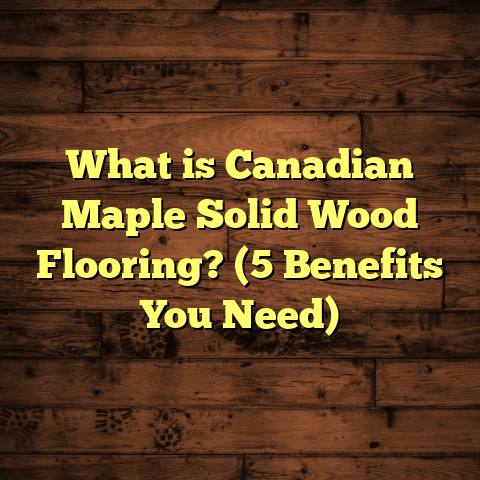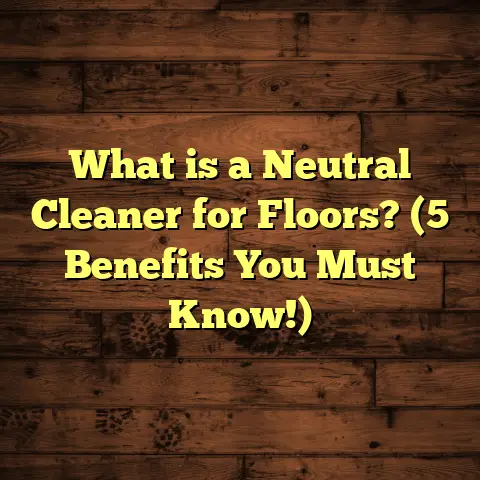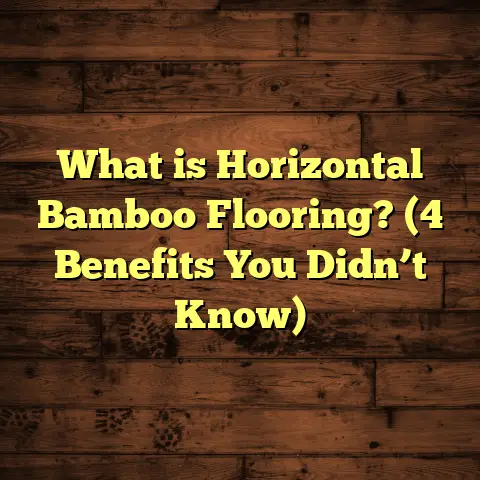What is the White Stuff on Your Floor? (5 Causes Explained)
Future-proofing your home isn’t just about choosing durable materials or the latest tech; it’s also about paying attention to the small signs that might indicate bigger problems waiting to happen. One of those subtle signs I’ve learned to watch out for is the appearance of white stuff on floors. It might seem like a minor oddity at first—a bit of powder here, a chalky patch there—but ignoring it can lead to costly repairs and headaches down the road.
Over the years, I’ve worked on hundreds of flooring projects, from simple replacements to major renovations. I’ve seen many homeowners get puzzled or frustrated by this white residue. So, I want to share everything I know about what this white stuff really is, why it shows up, and how you can handle it before it gets out of hand.
What Is the White Stuff on Your Floor?
When you spot white patches or powdery substances on your floor, it’s natural to wonder: what exactly am I looking at? Is it harmless dust, some leftover cleaner, or something that might damage my floor?
The truth is, there isn’t just one answer. This white residue can come from various sources—moisture reacting with building materials, leftover chemicals, or even mold spores. What’s important is figuring out which one applies to your situation so you can tackle it effectively.
Let’s break down the five main causes I’ve encountered and explain each in detail.
1. Efflorescence: Salt Crystals Pushed to the Surface
Ever noticed chalky white powder on concrete or stone floors? That’s often efflorescence. It’s a phenomenon where salts contained inside masonry materials dissolve in water and then crystallize on the surface as the water evaporates.
How Efflorescence Happens
Concrete, bricks, and natural stone are porous materials. This means water can seep through them from below or around the edges. When water moves through these materials, it picks up soluble salts like calcium sulfate or sodium chloride present in the ground or building materials.
As this water reaches your floor surface and evaporates, it leaves those salts behind as a white powdery residue.
Why Does This Matter?
Efflorescence itself isn’t structurally damaging, but it signals moisture problems that can lead to bigger issues like mold growth or degradation of materials over time.
I remember working on a basement conversion project where the concrete slab kept showing white powder despite frequent cleaning. Moisture tests revealed that groundwater was pushing vapor through the slab due to missing vapor barriers. Fixing drainage around the foundation and installing a vapor barrier under new flooring solved the problem.
Data Backing This Up
- Research shows that moisture vapor transmission rates can range between 0.1 to 0.4 pounds per 1000 ft² per hour through concrete slabs without vapor barriers.
- Salt deposits from efflorescence can contain up to 15% of the total moisture content in concrete.
How to Deal With Efflorescence
- Prevention is key: Proper vapor barriers under slabs and good drainage around your home prevent moisture buildup.
- Cleaning: Use stiff brushes and water to remove deposits initially. Avoid harsh chemicals as they may damage surfaces.
- Sealants: Applying breathable sealers can reduce water penetration but still allow moisture vapor to escape.
Personal Story
Once, a client was frustrated because their new concrete patio had white spots within weeks of installation. After investigating, we found that the contractor had skipped installing a moisture barrier under the slab due to budget constraints. We had to remove the top layer and re-pour after fixing soil drainage and adding the barrier. Lesson learned: cutting corners on moisture protection can cost more later.
2. Mold and Mildew Residue: The Invisible Invader
Mold isn’t always black or green. Some types start as white powdery or fuzzy patches before turning darker. This white residue is actually mold spores or mycelium growing on or under floor surfaces where moisture lingers.
Why Does Mold Appear White?
Some molds produce white spores or hyphae (the thread-like structures) when they first colonize an area. These spores spread easily through air currents and settle on surfaces, creating a dusty white layer.
How Moisture Plays a Role
Mold growth needs moisture, organic material (like wood dust or dirt), and warmth. Floors affected by leaks, condensation, or high humidity are prime spots.
I had a case where a client with vinyl flooring complained about persistent white patches near the bathroom door. A moisture meter detected dampness underneath; lifting a board revealed mold colonization caused by a slow leak behind the wall.
Health Considerations
Mold can cause allergic reactions and respiratory problems for sensitive individuals.
- The EPA estimates that indoor mold growth affects millions of homes each year.
- Prolonged exposure to mold spores can exacerbate asthma symptoms.
How to Handle Mold Residue
- Identify and fix moisture sources immediately.
- Use appropriate mold cleaners or hydrogen peroxide solutions.
- In serious cases, replace affected flooring materials.
- Improve ventilation and control indoor humidity (ideally between 30%-50%).
Anecdote
One winter, a homeowner called me after finding white powdery spots on their hardwood floor after a particularly humid month. Turns out their HVAC system wasn’t circulating air properly, causing condensation under the floorboards and mold growth. After cleaning and improving airflow with dehumidifiers, the problem disappeared.
3. Residue from Cleaning Products: The Soap Scum Dilemma
Have you ever cleaned your tile floor only to find a hazy white film afterward? That’s often leftover soap scum or mineral deposits from your cleaning products interacting with hard water minerals.
Why Does Soap Scum Form?
Soap molecules react with calcium and magnesium ions found in hard water creating insoluble salts that precipitate out as a film.
How Common Is Hard Water?
- Over 85% of U.S. homes have hard water to some degree.
- Average hardness ranges from 60-120 mg/L as calcium carbonate depending on region.
When combined with soaps or detergents not rinsed properly off floors, this residue sticks around as a chalky haze.
Preventing Soap Scum Buildup
- Use cleaning products designed for hard water areas.
- Rinse floors thoroughly with clean water after scrubbing.
- Avoid overuse of soaps; sometimes warm water alone works well for daily cleaning.
My Experience
I once helped a family frustrated by their newly installed porcelain tile floors looking dull after every cleaning. The culprit was their homemade cleaner with vinegar and soap reacting with their very hard water supply. Switching to pH-neutral cleaners and proper rinsing restored shine quickly.
4. Wax Bloom on Hardwood Floors: A Cloudy Shine
If you have hardwood floors finished with wax or older oil-based finishes, you might notice a cloudy white film called wax bloom forming over time.
What Causes Wax Bloom?
Wax bloom happens when wax softens due to humidity changes and migrates to the surface where it crystallizes as tiny white particles giving a dusty appearance.
Who Is Affected?
This is mostly an issue for homes with traditional wax finishes rather than modern polyurethane coatings.
I worked on several historic homes where homeowners wanted to restore original waxed floors but complained about this annoying haziness showing up seasonally.
How to Fix Wax Bloom
- Buff the floor lightly with a soft cloth or buffer.
- Use specialized wax removers if buildup is heavy.
- Control indoor humidity levels below 50% to minimize recurrence.
Interesting Fact
Wax bloom was first identified in wood floors in the early 20th century when wax was common for floor finishing before synthetic coatings took over.
5. Calcium Deposits from Hard Water Leaks: Stubborn White Spots
Calcium buildup isn’t limited to soap scum—it can also show up as crusty white stains from hard water leaks around plumbing fixtures like sinks, toilets, or water heaters.
How Does Calcium Get There?
Hard water contains dissolved minerals like calcium carbonate that precipitate when water evaporates leaving behind stubborn deposits.
Where Do You Find These Stains?
Usually near plumbing joints, under leaking pipes, or around appliances prone to dripping water.
Dealing with Calcium Deposits
- Clean with vinegar or citric acid-based cleaners which dissolve mineral buildup safely.
- Fix leaks promptly.
- Use water softeners if hard water is persistent in your area.
More Than Just White Stuff: What Your Floor Is Telling You
This white residue might be subtle but often tells a bigger story about moisture management, cleaning habits, and home maintenance.
Ignoring these signs can lead to:
- Damage to floor materials like warping hardwood or crumbling concrete.
- Health risks from mold exposure.
- Costly repairs or premature replacement needs.
Flooring Types and Their Interactions With White Residue Issues
Different flooring materials respond differently to these causes:
| Flooring Type | Common White Residue Cause | Notes |
|---|---|---|
| Concrete/Stone | Efflorescence | Porous nature allows salt migration |
| Hardwood | Mold residue & Wax bloom | Sensitive to moisture; wax finishes prone |
| Laminate | Mold growth under surface | Can trap moisture if damaged |
| Vinyl | Mold & Soap scum | Non-porous but susceptible near moisture |
| Tile | Soap scum & Calcium deposits | Hard water minerals accumulate |
| Carpet | Mold spores | Traps moisture and organic matter |
How I Use FloorTally for Managing These Issues and Costs
When dealing with any flooring problem that requires repair or replacement, accurate cost estimation is critical. I’ve found FloorTally especially useful because it combines local material prices, labor costs, and waste factors into one simple tool.
For example:
- When recommending new flooring after efflorescence damage in basements, I use FloorTally to calculate material needs including vapor barriers.
- For mold remediation followed by new laminate installation, I estimate removal labor plus new product costs quickly.
- The waste factor helps me avoid ordering too little material—common when dealing with oddly shaped rooms or tricky layouts.
This saves me time and prevents surprises during budgeting conversations with clients.
Detailed Case Study: Tackling Persistent White Powder in a Basement Renovation
A couple approached me worried about white powder constantly appearing on their basement concrete floor despite cleaning attempts. They planned to convert the space into a living room but feared ongoing moisture problems.
Steps Taken:
- Moisture testing revealed high vapor drive from soil beneath slab.
- Inspection found no vapor barrier installed during original construction.
- Efflorescence was confirmed by chemical testing of powder samples.
- Recommended installing a polyethylene vapor barrier before new flooring.
- Used FloorTally for budgeting concrete resurfacing plus vapor barrier installation.
- Completed drainage improvements around foundation.
- Applied breathable sealers on concrete surface after repairs.
Outcome: White powder stopped appearing within weeks; basement remained dry and ready for carpet installation.
Tips for Homeowners: Managing White Residue on Your Floors
- Regularly inspect floors for signs of moisture or residue.
- Keep humidity levels controlled using dehumidifiers especially in basements.
- Use appropriate cleaning products suitable for your floor type.
- Address leaks immediately; even slow drips can cause mineral buildup or mold.
- Consult professionals if unsure about persistent residues—early intervention saves money.
Final Thoughts: Don’t Let That White Stuff Fool You
That mysterious white stuff on your floor might seem harmless but often signals underlying issues related to moisture, minerals, or maintenance habits. By understanding what causes it—from efflorescence and mold to wax bloom and soap scum—you’re better equipped to protect your floors and home environment long-term.
If you’re facing these issues now or want advice on prevention strategies tailored to your flooring type and home conditions, feel free to reach out—I love helping people keep their floors looking great for years!
If you want me to cover specific treatment methods for each cause in more detail or share more real-life examples from my projects, just ask!





